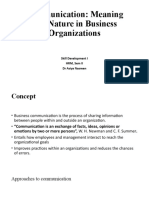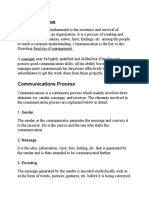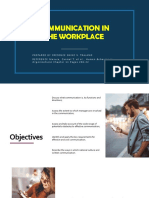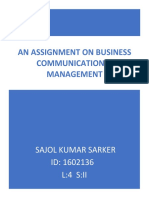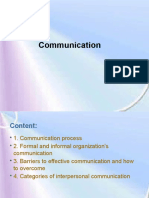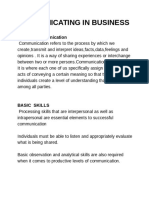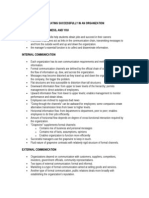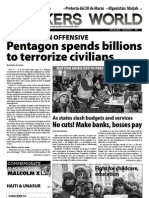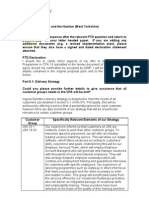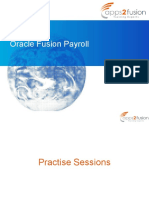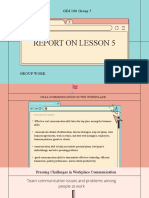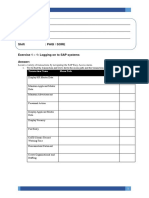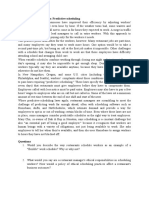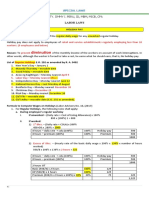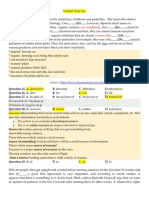SHRI VAISHNAV VIDYAPEETH VISHWAVIDYALAYA
TITLE
Assignment of Business Communication
B.A. (hons.)English Literature
6th semester, Final Year
SUBMITTED BY- Garima Sharma
ENROLLMENT NUMBER- 1709BAHNEL02385
SUBJECT- Business Communication
SUBMITTED TO- Dr. Shilpa Phadnis Ma’am
1
�I. Communication Channels
The number of communication channels available to a manager has increased
over the last 20 odd years. Video conferencing, mobile technology, electronic
bulletin boards and fax machines are some of the new possibilities.
As organizations grow in size, managers cannot rely on face-to-face
communication alone to get their message across.
A challenge the manager’s face today is to determine what type of
communication channel should they opt for in order to carryout effective
communication.
In order to make a manager's task easier, the types of communication channels
are grouped into three main groups: formal, informal and unofficial.
Formal Communication Channels
A formal communication channel transmits information such as the goals,
policies and procedures of an organization. Messages in this type of
communication channel follow a chain of command. This means
information flows from a manager to his subordinates and they in turn pass
on the information to the next level of staff.
An example of a formal communication channel is a company's newsletter,
which gives employees as well as the clients a clear idea of a company's
goals and vision. It also includes the transfer of information with regard to
2
� memoranda, reports, directions, and scheduled meetings in the chain of
command.
A business plan, customer satisfaction survey, annual reports, employer's
manual, review meetings are all formal communication channels .
Informal Communication Channels
Within a formal working environment, there always exists an informal
communication network. The strict hierarchical web of communication
cannot function efficiently on its own and hence there exists a
communication channel outside of this web. While this type of
communication channel may disrupt the chain of command, a good
manager needs to find the fine balance between the formal and informal
communication channel.
An example of an informal communication channel is lunchtime at the
organization's cafeteria/canteen. Here, in a relaxed atmosphere,
discussions among employees are encouraged. Also managers walking
around, adopting a hands-on approach to handling employee queries is an
example of an informal communication channel.
Quality circles, team work, different training programs are outside of the
chain of command and so, fall under the category of informal
communication channels.
Unofficial Communication Channels
Good managers will recognize the fact that sometimes communication that
takes place within an organization is interpersonal. While minutes of a
meeting may be a topic of discussion among employees, sports, politics and
TV shows also share the floor.
The unofficial communication channel in an organization is the
organization's 'grapevine.' It is through the grapevine that rumors circulate.
Also those engaging in 'grapevine' discussions often form groups, which
translate into friendships outside of the organization. While the grapevine
may have positive implications, more often than not information circulating
in the grapevine is exaggerated and may cause unnecessary alarm to
employees. A good manager should be privy to information circulating in
3
� this unofficial communication channel and should take positive measures to
prevent the flow of false information.
An example of an unofficial communication channel is social gatherings
among employees.
II. Grapevine Communication
Informal communication is also known as grapevine communication because
there is no definite route of communication for sharing information. Grapevine
means “the informal transmission of information, gossip or rumors from person
to person.” It is governed by social and personal relationships rather than
officially recognized rules and formalities. In this form of communication,
information converges a long way by passing from one person to another person
leaving no indication from which point it started. This is quite similar to the vine
of grapes. It is also difficult to find out the beginning and the end of the grapevine.
Grapevine network communicators can exercise positive or negative influences in
the organizational activities. Person of any rank can communicate with person of
any rank.
5 Ways to make Grapevine Beneficiary to Organization
1. Providing real news to the grapevine initiators.
2. Considering grapevine as a pulse feeling tool.
3. Contradicting the false rumor.
4. Allowing workers in the decision-making process
5. Developing a good organizational climate.
Types of Grapevine
The grapevine communication is usually horizontal in nature. But it can
be horizontal, vertical and diagonal. Prof. Keith Davis has classified grapevine into
4 types.
Single Strand Chain.
Gossip Chain.
Probability Chain.
Cluster Chain.
4
�III. Barriers to Communication
Any parameter that limits the purpose or channel of communication between the
transmitter and the receiver is a barrier to communication. A communication
barrier may limit or reduce the ease at which we communicate and hence the
name barrier. Although the barriers to effective communication may be different
for different situations, the following are some of the main barriers:
Linguistic Barriers
The language barrier is one of the main barriers that limit effective
communication. Language is the most commonly employed tool of
communication. The fact that each major region has its own language is one of
the Barriers to effective communication. Sometimes even a thick dialect may
render the communication ineffective.
As per some estimates, the dialects of every two regions changes within a few
kilometers. Even in the same workplace, different employees will have different
linguistic skills. As a result, the communication channels that span across the
organization would be affected by this.
Thus keeping this barrier in mind, different considerations have to be made for
different employees. Some of them are very proficient in a certain language and
others will be ok with these languages.
Psychological Barriers
There are various mental and psychological issues that may be barriers to
effective communication. Some people have stage fear, speech disorders, phobia,
depression etc. All of these conditions are very difficult to manage sometimes and
will most certainly limit the ease of communication.
Emotional Barriers
The emotional IQ of a person determines the ease and comfort with which they
can communicate. A person who is emotionally mature will be able to
communicate effectively. On the other hand, people who let their emotions take
over will face certain difficulties.
5
� A perfect mixture of emotions and facts is necessary for effective communication.
Emotions like anger, frustration, humour, can blur the decision-making capacities
of a person and thus limit the effectiveness of their communication.
Physical Barriers
They are the most obvious barriers to effective communication. These barriers
are mostly easily removable in principle at least. They include barriers like noise,
closed doors, faulty equipment used for communication, closed cabins, etc.
Sometimes, in a large office, the physical separation between various employees
combined with faulty equipment may result in severe barriers to effective
communication.
Cultural Barriers
As the world is getting more and more globalized, any large office may have
people from several parts of the world. Different cultures have a different
meaning for several basic values of society. Dressing, Religions or lack of them,
food, drinks, pets, and the general behaviour will change drastically from one
culture to another.
Hence it is a must that we must take these different cultures into account while
communication. This is what we call being culturally appropriate. In many
multinational companies, special courses are offered at the orientation stages
that let people know about other cultures and how to be courteous and tolerant
of others.
IV. Business Letter
A Business Letter is type of letter which serves as a means of communication
written for various commercial purposes. These purposes can be a business deal,
complaint, warning, notice, invitation, declaration, information, apology and
various other corporate matters. Letters of business are the most popular and the
most widely written types of letters. Business letters are also the oldest form of
official correspondence and perhaps the propagators of mailing system.
6
�Layout of Business Letter
You’re Contact Information
Your Name
Your Address
Your City, State Zip Code
Your Phone Number
Your Email Address
Date
Recipient's Contact Information
Name
Title
Company
Address
City, State Zip Code
Salutation
Dear Mr./Ms. Last Name:
Body of Letter
The first paragraph of your business letter should provide an introduction to why
you are writing.
Then, in the following paragraphs provide more information and details about
your request.
The final paragraph should reiterate the reason you are writing and thank the
reader for reviewing your request.
Closing:
Respectfully yours,
Signature:
Handwritten Signature (for a hard copy letter)
Typed Signature
7
�V. Parts of Business Letter
A business letter will be more impressive if proper attention is given to each and
every part of the business letter.
There are 12 Parts of Business Letter
The Heading or Letterhead
Date
Reference
The Inside Address
Subject
Greeting
Body Paragraphs
Complimentary Close
Signature and Writer’s Identification
Enclosures
Copy Circulation
PostScript
Let us discuss the parts of a business letter.
1. The Heading or Letterhead
It usually contains the name and the address of the business or an organization. It
can also have an email address, contact number, fax number, trademark or logo
of the business.
2. Date
We write the date on the right-hand side corner of the letter below the heading.
3. Reference
It shows the department of the organization sending the letter. The letter-number
can also be used as a reference
8
�4. The Inside Address
It includes the name, address, postal code, and job title of the recipient. It must
be mentioned after the reference. One must write inside address on the left-hand
side of the sheet.
5. Subject
It is a brief statement mentioning the reason for writing the letter. It should be
clear, eye catchy, short, simple, and easily understandable.
6. The Greeting
It contains the words to greet the recipient. It is also known as the salutation. The
type of salutation depends upon the relationship with the recipient.
It generally includes words like Dear, Respected, or just Sir/Madam. A comma (,)
usually follow the salutation.
7. The Body Paragraphs
This is the main part of the letter. It contains the actual message of the sender.
The main body of the mail must be clear and simple to understand. The body of
the letter is basically divided into three main categories.
Opening Part: The first paragraph of the mail writing must state the
introduction of the writer. It also contains the previous correspondence if
any.
Main Part: This paragraph states the main idea or the reason for writing. It
must be clear, concise, complete, and to the point.
Concluding Part: It is the conclusion of the business letter. It shows the
suggestions or the need of the action. The closing of the letter shows the
expectation of the sender from the recipient. Always end your mail by
courteous words like thanking you, warm regards, look forward to hearing
from your side etc.
9
� 8. The Complimentary Close
It is a humble way of ending a letter. It is written in accordance with the
salutation. The most generally used complimentary close are yours faithfully,
yours sincerely, and Thanks & Regards.
9. Signature and Writer’s Identification
It includes the signature, name, and designation of the sender. It can also include
other details like contact number, address, etc. The signature is handwritten just
above the name of the sender.
10. Enclosures
Enclosures show the documents attached to the letter. The documents can be
anything like cheque, draft, bills, receipts, invoices, etc. It is listed one by one.
11. Copy Circulation
It is needed when the copies of the letter are sent to other persons. It is denoted
as C.C.
12. PostScript
The sender can mention it when he wants to add something other than the
message in the body of the letter. It is written as P.S.
VI. Job Application Letter
Resume
VII. How to Prepare For an Effective Oral Presentation.
VIII. Short Note On:
Interview Skills
Interviewing is a skill in and of itself, one in which your ability to interact with the
interviewer and to articulate your thoughts are factors that are just as important
in getting the job as are the qualifications listed on your resume.
10
�Interview Preparation
Here’s a sample formula outlining a 60-minute preparation exercise:
5 minutes re-reading and analyzing the job description, focusing on the
essential requirements and responsibilities, in order to tailor your answers
and to home in on the most important aspects of the job.
5 minutes re-reading your resume and cover letter to review how you
pitched yourself in the first place.
15 minutes researching potential interview questions specific to the
position and the industry.
20 minutes practicing answers to these questions and recalling specific
examples from your work experience, such as major accomplishments,
challenges, or milestones that will serve as anecdotes to strengthen your
responses to situational and behavioral-based interview questions.
15 minutes researching the company, looking into their history, mission and
values, and recent projects.
Indeed, practice makes perfect. In addition to practicing these steps on your own,
ask a friend or family member to pose as an interviewer so you can get used to
answering questions in real time.
Be on Time
There are very few (if any) excuses that will redeem a late arrival. Do whatever
you need to do to get there ten to 15 minutes in advance of your interview time,
whether it’s planning your outfit and packing your bag the night before, setting
five alarms, asking a friend to give you a wake-up call, or leaving extra early to
account for potential transportation obstacles.
Avoid the “ums” and “uhs” and buy yourself time by repeating the interviewers'
questions back to them, or by using a phrase like, “That’s an interesting
question!” or, “I was actually just thinking about that when I read an article on a
similar topic, and…”
If you’re really stumped, you can say, “What a great question. I’ve actually never
been asked this before; let me just take a second to think about this.”
Finally, know what to do if you really can’t answer a question.
11
� Speak Clearly, Cohesively, and Calmly
Nerves can get you talking a mile a minute, and so can the simple desire to convey
as much valuable information about yourself as possible. However, talking too
fast can make you look rushed, flustered or anxious. Make a conscious effort
to slow down and speak calmly and clearly. It will help you avoid interview stress.
Be Confident, Not Arrogant
Although you should be willing and able to promote yourself, your experience,
and your accomplishments, make sure you don’t come across as arrogant,
narcissistic, or self-important. No matter how good you are at your job, you’re
going to run into countless obstacles if you lack the emotional intelligence to work
on a team and get along with managers, co-workers, or clients.
Focus on exuding a kind and balanced sense of confidence, and when you discuss
your achievements; be sure to give credit where credit is due in order to show
that you’re a team player.
However, if you don’t listen well in the first place, you might miss the entire point
of the question, and as a result, your answer could fall totally flat.
Stay in the moment and don’t let yourself zone out, even if it feels like the
interviewer is endlessly blabbing on. Preparation will help tremendously (so
that you have material ready to discuss and won't have to come up with it all on
the spot), but good listening skills and the ability to stay focused are key.
Express Optimism, Both with Your Words and Your Body Language
No company wants to hire someone with a bad attitude. No matter how difficult
your situation is, don’t bring any baggage into the interview room. That means
don’t bad-mouth your former employer or any other companies you’ve been
associated with, and don’t complain about your personal circumstances.
Be natural, expressing reasonable perspectives through a lens of optimism. For
example, if you have to talk about a challenging situation, you should include a
mention of how you may have helped solve it, and what you learned that made
you a better employee. Remember, your body language does matter as much as
12
�your words. Walk in with a smile on your face, offer a firm handshake, and sit up
tall at the table, leaning slightly forward to engage in the conversation.
Show Interest, Without Desperation
Sometimes, it can be helpful to think of an interview as a (professional) first date.
An air of disinterest, apathy, or monotony will likely turn off an interviewer, as will
overenthusiastic desperation. No matter how much you want or need the job,
refrain from acting desperate; pleading or begging has no place in a job interview.
The key is to express earnest interest in the role and in the company, and passion
for the work you do. Keep in the back of your mind that you are a valuable asset
as an employee.
Know More Than Your Elevator Pitch
Although you should be able to give an elevator pitch in which you introduce
yourself, recap your experience, and promote your most valuable professional
assets, make sure you’re comfortable talking about yourself beyond that. Know
how to discuss both your strengths and weaknesses, and emphasize your best
qualities and greatest skills, while putting a positive spin on your areas of
improvement.
You should also be able to exert some level of control over the conversation. For
example, if an interviewer tries to trip you up with a tricky question like, “Have
you ever had a bad experience with an employer?” or “Tell me about a time a
coworker was unhappy with you,” you should be able to answer their question
while bridging your response into a positive: an idea or example that shows how
you learned or grew from the situation. You should also have questions of your
own to ask the interviewer.
Express Gratitude
Don’t underestimate the importance of saying “Thank you.” As soon as your
interview concludes, you should thank your interviewers for their time and for the
opportunity to learn more about the position. When you get home, you should
always follow up with a thank-you email. Otherwise, the interviewer may take
your silence as a sign that you aren’t really interested in the position.
13
� Negotiation skills
Negotiation is a type of discussion used to settle disputes and reach agreements
between two or more parties. Generally, a negotiation results in a compromise
where each party makes a concession for the benefit of everyone involved.
Negotiations occur frequently within the workplace and may occur between
coworkers, departments or between an employee and employer. Professionals
may negotiate contract terms, project timelines, compensation and more.
Negotiations are both common and important, so it’s helpful to understand the
types of negotiations you might encounter as well as how to improve your
negotiation skills.
Negotiation skills are qualities that allow two or more parties to reach a
compromise. These are often soft skills and include abilities such as
communication, persuasion, planning, strategizing and cooperating.
Understanding these skills is the first step to becoming a stronger negotiator.
Here are a few key negotiation skills that apply to many situations:
Communication: Essential communication skills include identifying
nonverbal cues and expressing yourself in a way that is engaging. It is
important to understand the natural flow of conversation and always ask
for feedback. Active listening skills are also crucial for understanding the
other party. By establishing clear communication, you can avoid
misunderstandings that could prevent you from reaching a compromise.
Persuasion: The ability to influence others is an important skill for
negotiation. It can help you define why your proposed solution is beneficial
to all parties and encourage others to support your point-of-view.
Planning: In order to reach an agreement that benefits both parties, it is
crucial you consider how the consequences will impact everyone in the
long-term. Planning skills are necessary not only for the negotiation process
but also for deciding how the terms will be carried out.
Strategizing: The best negotiators enter a discussion with at least one
backup plan, but often more. Consider all possible outcomes, and be
prepared for each of these scenarios.
14
�15














